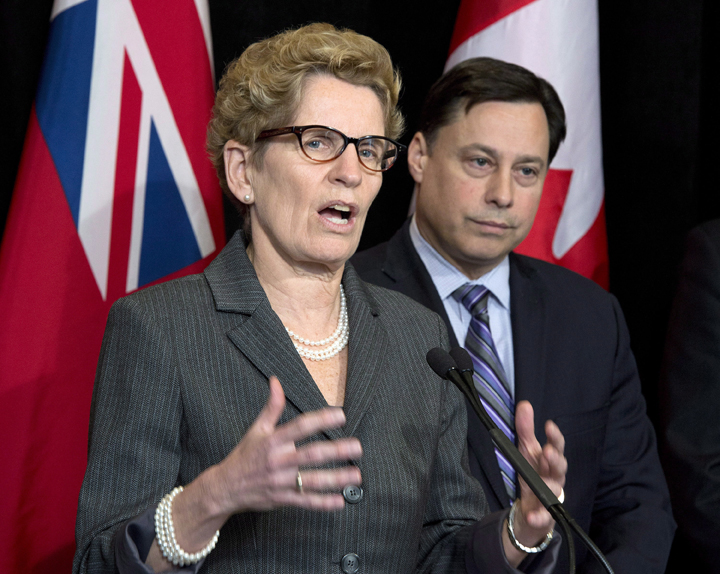TORONTO – Higher taxes or further spending cuts will likely be needed if Ontario’s Liberal government is to keep its promise of balancing the books in three years, the Conference Board of Canada said in a report Thursday.

The board’s fiscal snapshot of Ontario said that a slowdown in revenue growth will likely mean Ontario can’t eliminate its $12.5-billion deficit by 2017-18 “despite its ambitious spending control plan.”
Without more spending cuts or tax increases Ontario could fall $2.4 billion short of reaching its goal, the report said. The government will have to make some tough decisions and go beyond its spending restraint plan as outlined in the 2014 budget, said Matthew Stewart, an associate director of economic forecasting.
“I don’t think it’s impossible at all,” he said.
“They do have a number of options, but it will certainly require more than, I think, than they’ve currently got in their budget.”
The conference board worked from the government’s overall targets for program expenditures as outlined in the budget, but “even then, based on our weaker revenue projections, the government is unlikely to balance its books on schedule,” the board said in its report.
The Liberal government insists it’s on track to eliminate the deficit in 2017-18.
“For each of the last five years our government’s prudent approach has led to significantly lower than projected deficits,” Susie Heath, a spokeswoman for Finance Minister Charles Sousa, said in a statement.
- Freeland set to table 2024 federal budget in the House of Commons
- Budget 2024: Liberals look to offset drug plan cost with higher smoking, vaping taxes
- Tired of after-hours emails? Budget 2024 plans ‘right to disconnect’
- Budget 2024 commits $5B for Indigenous loan guarantees, but falls short on infrastructure
“The minister and the new president of the Treasury Board will continue to transform government and ensure the savings targets we have established in the budget are met.”
Stewart said balance could be achieved if the government pushes spending restraint to a fourth year, in 2018-19, or if it increases taxes to make up the difference, or if it reins in spending even further.
“They can continue to do what they have done in the past, which is protect health care and education as much as possible, and then continue to cut other spending,” he said. “That’s probably the most likely course.”
The conference board notes the province’s program spending increased by an annual average of 5.1 per cent over the last 10 years.
Progressive Conservative critic Vic Fedeli doubts the government will take aim at spending.
“They’re addicted to spending,” he said. “They say one thing but do the other. That’s what we’ve seen so far.”
The conference board also pointed to sluggish growth, saying Ontario’s economy has been “stuck in a rut” for the past two years. Real GDP is set to grow by 1.5 per cent this year, which is lower than the budget projection of 2.1 per cent, the board noted.
Growth is set to improve in 2015, though the board doesn’t expect that to last. The question mark is what lies beyond 2015, Stewart said.
“We’ve seen no increase in business investment. It’s expected to decline for the third straight year. So what’s going to happen to 2016, 2017, which is really when they have the majority of their spending restraint?” he said.
The finance minister’s spokeswoman said they have been clear that growth has been slower than expected.
“That’s why we’re working to increase revenues to help grow the economy,” Heath wrote. “We’ll balance the budget in 2017-18, but we won’t sacrifice the investments that are needed to keep us competitive. Once we eliminate the deficit, we will ensure the debt-to-GDP ratio returns to its pre-recession level.”
NDP critic Catherine Fife said in a statement that the conference board report raises “serious questions” about the government’s deficit targets. The New Democrats have said the Liberals need to raise taxes on corporations in order to get a steady revenue stream to eliminate the deficit.
Ontario’s deficit for fiscal 2013-14 came in at $10.5 billion, $800 million lower than forecast, after a $1-billion reserve was used to offset lower-than-projected tax revenues and transfer payments from the federal government.
In July, Moody’s Investors Service changed Ontario’s debt outlook from stable to negative, citing concerns over the government’s ability to eliminate the deficit as scheduled.

Comments